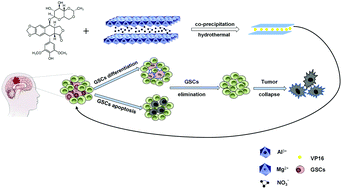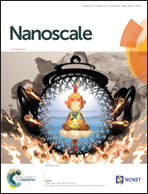Etoposide loaded layered double hydroxide nanoparticles reversing chemoresistance and eradicating human glioma stem cells in vitro and in vivo†
Abstract
Glioblastoma (GBM) is the most malignant and lethal glioma in human brain tumors and contains self-renewing, tumorigenic glioma stem cells (GSCs) that contribute to tumor initiation, therapeutic resistance and further recurrence. In this study, we combined in vitro cellular efficacy with in vivo antitumor performance to evaluate the outcome of an etoposide (VP16) loaded layered double hydroxide (LDH) nanocomposite (L-V) on human GSCs. The effects on GSC proliferation and apoptosis showed that loading with LDH could significantly sensitize GSCs to VP16 and enhance the GSC elimination. Further qPCR and western blot assays demonstrated that L-V could effectively attenuate GSC related pluripotency gene expression and reduce the cancer stemness. An in vivo GSC xenograft mice model showed that L-V can overcome drug resistance, eradicate GSCs, sharply decrease the stemness and reverse the epithelial–mesenchymal transition (EMT). RNA-seq analysis elucidated that L-V plays a vital role by down-regulating the PI3K/AKt/mTOR expression and activating the Wnt/GSK3β/β-catenin signaling pathway, hence leading to GSC stemness loss and greatly enhancing the GSC targeting effect. Taken together, this study demonstrated the outstanding performance of L-V reversing the drug resistance of GSCs, thus providing a novel strategy for clinical translation application of nanomedicine in malignant glioma chemotherapy.



 Please wait while we load your content...
Please wait while we load your content...